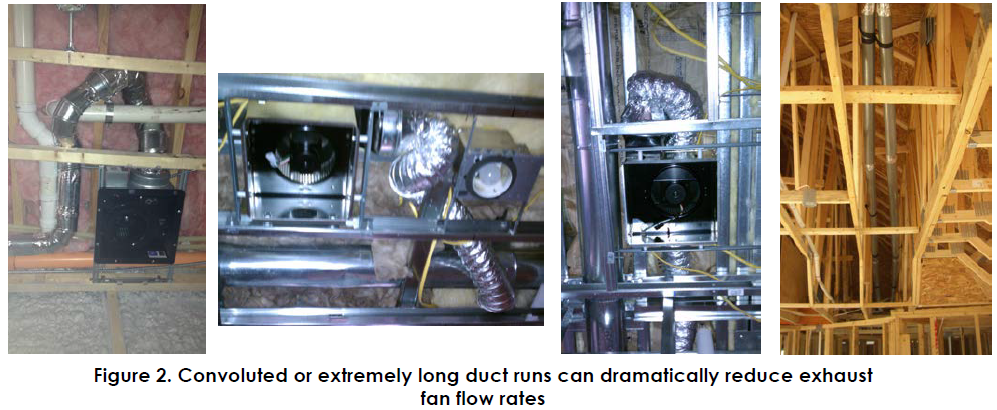- September 14, 2018
- 0 Comments
- In Existing Building Performance Residential Home Performance
- By
You most likely don’t even think about it when using the bathroom. Flip the switch, hear the exhaust fan, and everything is working as it is intended…right? Far too often, the answer is NO, and it is no fault of the user. Sure, homeowners should take a minute each year to vacuum the inside of the exhaust fan housing, but otherwise, these fans should just work. So why don’t they? Hint…it all depends on how it was sized and installed.
Background
The purpose of exhaust ventilation is to remove contaminants (including moisture) that can compromise health, comfort, and durability. Exhaust fans are amongst the simplest mechanical systems in your home, but decades of experience working in homes has shown us that even the easiest things can get screwed up. Far too often, exhaust fans rated for 50 or 80 cubic feet per minute (cfm) of air removal are actually operating at less than 20 cfm. In theory, the exhaust fan should be installed in a suitable location and then ducted to the outside via the most direct path possible. However, the installation of an exhaust fan can involve up to three trades: an electrician typically installs and wires the unit; an HVAC contractor supplies the ductwork; and, the builder/sider/roofer may install the end cap termination. What could go wrong?
As energy efficiency standards and construction techniques have improved over time, new and retrofitted buildings have become more and more air-tight. If not properly addressed, this air-tightness can lead to moisture issues. Quickly removing moisture generated from showers is a key component of any moisture management strategy. While manufacturers have made significant advancements in the performance, durability, and controls of exhaust fans, these improvements can all be side-stepped by a poor installation.
So how do you correct this issue? Proper installation, of course, but the only way to be certain is to measure the exhaust airflow after installation. In a recent project, I inspected what appeared to be a perfectly installed exhaust fan (exhaust fan collar facing the exterior wall and five feet of straight sheet metal duct to a side wall termination cap) and it sounded as though it was pulling a lot of air. However, when I actually tested the 80 cfm rated fan, it was only pulling 5 cfm. After a little investigation, I found that the installer used screws to secure the duct to the exhaust fan collar and the screws impeded the opening of the built-in backdraft damper. So, while eyes and ears can help, the only way to truly verify performance is by quantitative measurement.
The Problem
The ability of an exhaust fan to move air is dependent on the amount of static pressure that the fan must overcome between the fan and its termination outdoors. The static pressure, typically measured in inches of water gauge (iwg), depends on the size and length of ductwork, the number and type of bends in the ductwork, and the type of termination cap. Current exhaust fans are rated for outputs at static pressures of 0.1 iwg as the industry standard and 0.25 iwg if ENERGY STAR rated. These pressure ratings are meant to represent various typical installation configurations. However, the current rating demarcations of 0.1 and 0.25 do not accurately reflect the reality of many installation procedures.
Fan housing installations such as those shown in Figure 1 are not great, but exhaust fan DC motor technology may be able to overcome these duct restrictions (and restrictions of the termination cap). Unfortunately, it is far too common to see fan installations as shown in Figure 2.
While flex duct has its advantages, it adds resistance when used for exhaust fan ducting. Its flexibility enables contractors to force the duct to do things it really shouldn’t and rarely results in installation per manufacturer’s specifications: “Install duct fully extended, do not install in the compressed state or use excess lengths.”
As installation practices have a significant impact on fan performance, it is essential to measure airflow rates to verify proper operation. This is why ENERGY STAR® certification requires testing of all local mechanical exhaust flow rates. Category 8 of the Rater Field Checklist for ENERGY STAR Certified Homes, Version 3/3.1 (Rev. 09), states that Rater-measured airflow is required for compliance. Whether this is being properly enforced is a separate matter.
Read Part 2 of this blog, which covers solutions and best practices for installing bathroom exhaust ventilation.
By Srikanth Puttagunta, Principal Mechanical Engineer



